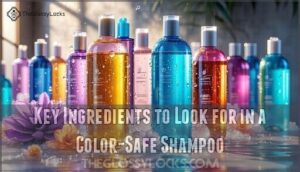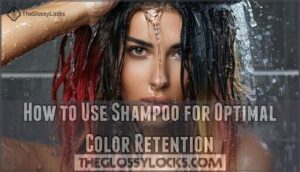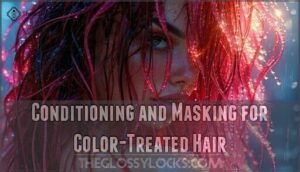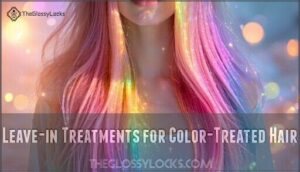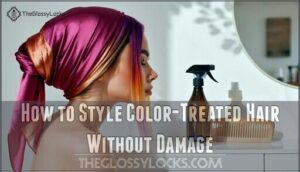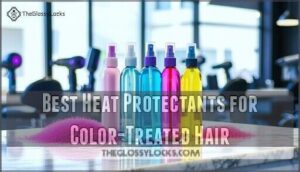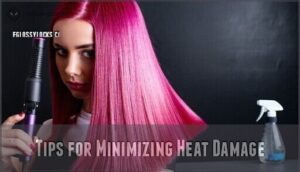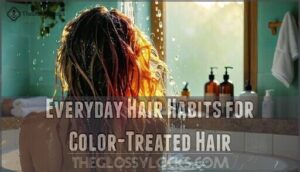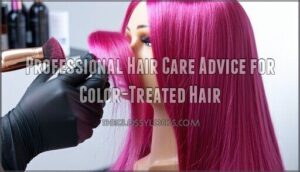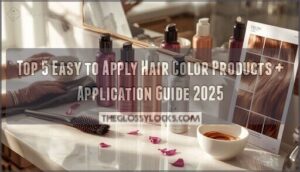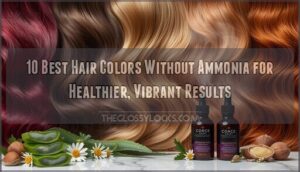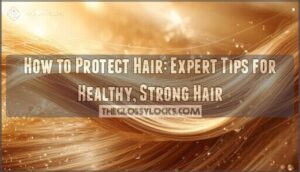This site is supported by our readers. We may earn a commission, at no cost to you, if you purchase through links.
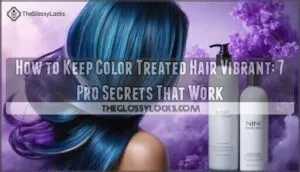
You’ll want to ditch sulfate-packed shampoos that strip color faster than you can say "oops."
Instead, embrace color-safe formulas and lukewarm water—hot showers might feel amazing, but they’re your hair color’s worst enemy.
Deep conditioning treatments become your new best friend, locking in moisture and preventing that dreaded fade.
Heat styling? Use it sparingly and always with protection.
Think of your colored hair like a delicate silk scarf—it needs gentle handling to maintain its brilliance.
The secret lies in understanding what truly sabotages color longevity.
Table Of Contents
- Key Takeaways
- Color-Treated Hair 101
- Ingredients to Avoid for Vibrant Color
- Choosing The Right Shampoo for Color-Treated Hair
- Conditioning and Masking for Color-Treated Hair
- Leave-in Treatments for Color-Treated Hair
- Styling and Heat Protection for Color-Treated Hair
- Everyday Hair Habits for Color-Treated Hair
- Maintaining Color-Treated Hair at Home
- Professional Hair Care Advice for Color-Treated Hair
- Frequently Asked Questions (FAQs)
- How do you keep color-treated hair healthy?
- How do you care for color treated hair?
- Does color-treated hair fade over time?
- How to prevent damage when coloring hair at home?
- How do you keep red hair color vibrant?
- How to keep dyed hair vibrant?
- How do you keep color-treated hair from fading?
- How to make permanent hair dye more vibrant?
- How can I make my dyed hair brighter?
- How can I make my color treated hair last longer?
- Conclusion
Key Takeaways
- Switch to sulfate-free shampoo – You’ll prevent color stripping and fading by avoiding harsh detergents that open hair cuticles and wash away pigments with every rinse.
- Use lukewarm water and limit washing frequency – You’ll lock in color by washing 2-3 times weekly with cool-to-lukewarm water instead of hot water that opens cuticles and releases color molecules.
- Apply heat protectants and minimize styling damage – You’ll preserve vibrancy by using thermal protection sprays before any heat styling and embracing air-drying whenever possible to reduce color fade.
- Deep condition weekly and use leave-in treatments – You’ll maintain moisture and create a protective barrier against environmental damage by incorporating weekly masks and daily leave-in products that seal cuticles and lock in pigments.
Color-Treated Hair 101
You’ve probably spent hours perfecting your hair color, but keeping it vibrant requires more than just wishful thinking.
Understanding what color-treated hair actually is and how it differs from your natural locks is the first step to maintaining that salon-fresh look at home.
What is Color-Treated Hair?
Color-treated hair isn’t just about the vibrant hair color you’re sporting—it’s hair that’s been through chemical processes like dyeing, bleaching, or highlighting.
Your hair has been chemically altered—it’s different now and needs different care.
These treatments alter your hair’s structure by lifting the cuticle, increasing hair porosity and damage potential.
The result? Your hair texture becomes drier and more fragile than before.
Understanding this color alteration helps you care for your color-treated hair properly.
This process often leads to increased hair fragility, which is a key consideration for proper care and maintenance of color-treated hair.
How Does Color-Treated Hair Differ From Virgin Hair?
If you’ve ever wondered why your hair feels different after coloring, you’re not alone.
Compared to virgin hair, color treated hair faces real challenges:
- Porosity Differences mean your hair absorbs and loses moisture like a leaky bucket.
- Cuticle Damage leaves strands rough and fragile.
- Moisture Retention drops, making hair thirsty for hydration.
- Structural Changes cause elasticity loss, so hair protection and cuticle protection matter more than ever.
Common Types of Color Treatments
Transforming your locks means choosing from several popular techniques.
All-over color creates uniform coverage, perfect for dramatic changes or gray coverage.
Balayage offers natural-looking highlights with hand-painted dimension.
Traditional highlight techniques brighten specific sections, while lowlight effects add depth.
Whether you’re going auburn or icy blonde, each method enhances hair color vibrancy differently.
Your color treated hair journey starts with picking the right technique for your desired look.
Ingredients to Avoid for Vibrant Color
The wrong ingredients in your hair products can strip away your beautiful color faster than you’d like.
That’s why knowing what to avoid is just as important as choosing the right products for your color-treated hair.
Sulfates and Their Impact on Color-Treated Hair
Switching to sulfate-free shampoo saves your color investment from going down the drain.
These harsh detergents wreak havoc on color-treated hair, stripping away both natural oils and precious pigments.
- Sulfate damage opens hair cuticles, allowing color molecules to escape
- Gentle cleansing alternatives preserve your hair’s protective barrier
- Color-safe shampoo maintains vibrancy while removing buildup effectively
- Sulfate-free benefits include reduced fading and improved moisture retention
Parabens and Their Effects on Hair Color
Parabens aren’t just preservatives—they’re color killers that accelerate hair color fading and trigger scalp irritation.
These sneaky chemicals penetrate your hair shaft, causing hair damage from the inside out.
When shopping, scan product labels for paraben alternatives like phenoxyethanol or potassium sorbate.
Your color safe shampoo and sulfate free shampoo should work together for maximum hair color protection.
Sodium Chloride and Petrochemicals: What to Watch Out For
Two troublemakers lurk in product labels: sodium chloride and petrochemicals.
These hidden ingredients strip natural oils, accelerate hair color fading prevention efforts, and leave your color treated hair care routine working overtime.
Check labels religiously—alternative options include sulfate free shampoo and petrochemical-free formulas that actually protect your investment instead of sabotaging it.
Choosing The Right Shampoo for Color-Treated Hair
Your shampoo can make or break your hair color’s staying power, so choosing the right formula is essential for maintaining that salon-fresh vibrancy.
The secret lies in finding sulfate-free options packed with color-protecting ingredients that cleanse gently without stripping away your investment.
Key Ingredients to Look for in a Color-Safe Shampoo
After knowing what to avoid, focus on sulfatefree shampoo with powerhouse ingredients for color treated hair care.
Gentle cleansers like sodium lauroyl sarcosinate protect your investment without harsh stripping. Hunt for hydrating agents such as glycerin and aloe vera—they’re moisture magnets that keep color locked in.
Amino acids and keratin repair damage while antioxidants like vitamin E fight environmental stressors. Don’t forget UV protectants—they’re SPF for your strands!
As some sulfates can strip moisture, consider using milder sulfate alternatives for better color retention. These colorsafe products work together like a dream team, ensuring your hair color care products deliver salon-worthy results at home.
How to Use Shampoo for Optimal Color Retention
Perfect technique makes all the difference when using your colorsafe shampoo. Start with lukewarm water since hot temperatures open hair cuticles, letting precious color molecules escape. Apply a quarter-sized amount of sulfatefree shampoo to wet hair, focusing on your scalp rather than the lengths—this promotes scalp health without over-cleansing.
Your shampoo frequency matters more than you think. Washing every other day keeps color locked in while maintaining cleanliness. Between washes, dry shampoo becomes your best friend for revitalizing roots.
Here’s your gentle cleansing roadmap:
- Wet hair thoroughly with cool-to-warm water
- Massage shampoo into scalp using fingertips, not nails
- Rinse completely—leftover product dulls color
- Follow with conditioner from mid-length to ends
- Finish with a cool water rinse to seal cuticles
These hair washing tips protect your investment while keeping strands healthy and vibrant. To further enhance color longevity, consider using shampoos with color protecting ingredients.
Conditioning and Masking for Color-Treated Hair
Think of conditioning as giving your color-treated hair a much-needed drink after it’s been through the chemical wringer.
Your hair’s thirsty cuticles need that extra moisture to lock in pigment and prevent your gorgeous color from washing down the drain, which is why conditioning is essential to maintain the color.
The Importance of Moisturizing Color-Treated Hair
After choosing the right shampoo, your color-treated hair craves moisture like a thirsty plant needs water.
Chemical processes increase porosity levels, making moisture retention challenging. Without proper hair hydration, you’ll face frizz control issues and faster color fading.
Hair Health Dryness Benefits
Deep conditioning becomes your secret weapon for hair color maintenance and lasting hydration benefits.
Best Conditioners and Masks for Color-Treated Hair
Anyone with color-treated hair knows a good conditioner or mask is like a tall drink of water for thirsty strands.
For a real Hydration Boost and Protein Balance, try these standouts:
- IGK Expensive Amla Oil Hi-Shine Topcoat
- Shu Uemura Color Lustre Brilliant Glaze Conditioner
- Kérastase Chroma Absolu Strengthening Conditioner
- Briogeo Superfoods Mango + Cherry Oil Control & Balancing Conditioner
Shine, softness, and color vibrancy await. Masks with ingredients like Salina Caper Blossom Extract can provide color protecting benefits for a color protecting effect.
How to Deep Condition for Maximum Color Vibrancy
With the right conditioners and masks in your arsenal, it’s time to master the art of deep conditioning for maximum color vibrancy. Think of it as giving your hair a weekly power-up session.
Deep Conditioning Schedule & Benefits
| Frequency | Key Benefits |
|---|---|
| Weekly | Locks in moisture, prevents fading |
| Bi-weekly | Boosts elasticity and shine |
| Monthly | Repairs damage, improves porosity |
| As needed | Revives dull tones, adds nourishment |
| Before swimming | Creates protective barrier |
Application Techniques matter more than you’d think. Start with damp hair, apply your mask from mid-length to ends, and use a wide-tooth comb for even distribution. Hydration Boosters like argan oil can amplify results.
Frequency Matters – overdoing it can weigh hair down, while skipping sessions leads to dryness. Mask Ingredients should target your specific needs: protein for strength or moisture for hydration. Some masks offer Toning Effects to neutralize brassiness while conditioning.
To find the best option for your hair, consider a quality conditioning product.
Leave-in Treatments for Color-Treated Hair
Leave-in treatments act like a protective shield for your color-treated hair, locking in moisture and creating a barrier against environmental damage that can cause fading.
You’ll get the best results by applying these products to damp hair from mid-length to ends, focusing on the most porous areas where color tends to fade first.
Benefits of Leave-in Treatments for Color-Treated Hair
Leave-in treatments become your color-treated hair’s best friend, delivering essential benefits that keep your locks looking salon-fresh.
These multitasking heroes work around the clock to protect and nourish your strands.
Here’s what leave-in treatments bring to your hair game:
- Hydration Boost – Deep moisture that penetrates damaged cuticles
- Frizz Control – Smooths unruly strands for polished styling
- UV Protection – Shields color from sun damage and fading
- Color Retention – Locks in pigments for longer-lasting vibrancy
- Damage Repair – Rebuilds weakened hair structure over time
Think of leave-in treatments as your hair’s daily vitamin.
They create a protective barrier while continuously feeding your color-treated hair the moisture it craves, ensuring your hair vibrancy stays intact between salon visits.
Many users also find that leave-in treatments help to prevent accelerated color fading, a common issue with color-treated hair.
How to Use Leave-in Treatments for Maximum Color Retention
Now that you know the benefits, here’s how to master application techniques for maximum color retention.
Apply your leave-in treatments to damp hair, concentrating on the ends where damage shows first. This gives you the best ingredient benefits and hydration boost.
| Application Method | Color Protection Benefit |
|---|---|
| Damp hair application | Locks in moisture and pigment |
| End-focused technique | Prevents color fade at tips |
| SPF-infused products | Shields from UV damage |
Product layering works wonders too. Mix your hair mask with regular conditioner weekly for an intense moisture treatment.
This simple trick keeps your color-treated hair looking salon-fresh longer. Remember, UV protection isn’t just for your skin—your hair vibrancy depends on it.
These smart moves will keep your hair color retention strong.
Styling and Heat Protection for Color-Treated Hair
Heat styling doesn’t have to spell disaster for your freshly colored hair, but it does require some smart strategies.
You’ll need the right products and techniques to keep your color looking salon-fresh while still achieving your favorite styles.
How to Style Color-Treated Hair Without Damage
How can you protect your color while styling?
Embrace heatless styling methods like braids or silk scarves for protective hairstyles.
When heat’s necessary, apply heat protectant spray before using hair styling tools.
Practice gentle brushing with wide-tooth combs, and avoid product buildup that dulls hair color vibrancy.
Your locks will thank you with lasting brilliance and hair heat protection.
Best Heat Protectants for Color-Treated Hair
Finding the right heat protectant spray can make or break your color-treated hair game.
Look for heat protectant ingredients like silicones and UV absorbers that shield up to 450°F while locking in moisture. The best products are sulfate-free and paraben-free, helping your hair stay vibrant longer.
Using a quality product can minimize heat damage.
Here are top picks for color-treated hair:
- dpHUE Color Fresh Thermal Protection Spray – Perfect for color preservation and oil-prone hair
- Redken Acidic Color Gloss Leave-In Treatment – Balances pH while protecting up to 450°F
- Not Your Mother’s Beat The Heat Spray – Combines heat and UV protection with antioxidants
- Living Proof Restore Perfecting Spray – Works across all hair types for maximum color retention
Apply these hair color vibrancy tips before styling for smooth, protected results.
Tips for Minimizing Heat Damage
Why settle for damaged locks when you can style smarter?
Lower your heat settings and keep tools moving to prevent hot spots.
Heat protectants create a barrier against hair damage while air drying partially before styling reduces exposure time.
Gentle styling with limited styling sessions protects your hair’s porosity, preventing breakage and keeping color vibrant longer.
Everyday Hair Habits for Color-Treated Hair
Your daily routine plays a huge role in keeping your color vibrant and healthy.
Small changes to how you wash, dry, and style your hair can extend your color’s life by weeks.
Ditch The Sulfates: Why Sulfate-Free is Best
Sulfates act like harsh detergents, stripping your hair color along with natural oils.
Think of sulfates as your hair color’s worst enemy—they wash away your investment with every rinse.
These aggressive cleansers open hair cuticles, allowing precious pigments to escape down the drain.
Sulfatefree alternatives offer gentle cleansing without compromising color longevity.
Your colortreated hair deserves products that nurture rather than assault.
Check product ingredients carefully—your vibrant hair color depends on avoiding scalp irritation and chemical damage.
Turn Down The Temperature: How Water Temperature Affects Color
Hot water opens your hair’s cuticle like a flower blooming, making color molecules escape faster than you’d like.
Cool things down for better hair color vibrancy maintenance with these simple hair color retention strategies:
- Rinse with lukewarm water to reduce porosity levels
- Finish with cold water for cuticle sealing
- Keep showers under 5 minutes
- Use cooler temperatures when washing color-treated sections
Remember: hot water equals faster color fading, so it’s essential to follow these guidelines to maintain your hair color vibrancy, and cool things down can make a significant difference.
Air Dry Whenever Possible: Minimizing Heat Exposure
After you’ve cooled off with lukewarm water, give your hair a break from heat.
Embrace air-dry benefits by letting your hair dry naturally—your color will thank you!
Try these easy tips:
- Use a microfiber towel for gentle drying
- Pair with leave-in conditioners for scalp health and vibrancy
- Explore heat-free styles for everyday hair color protection strategies
Your strands will love the rest!
Blow Dry With Caution: Tips for Safe Heat Styling
When blow-drying becomes inevitable, smart heat protectant application shields your color investment.
Keep your dryer on medium heat with nozzle attachments for focused airflow, maintaining six inches distance from strands.
These blow-dry techniques and temperature control strategies preserve hair color vibrancy while delivering salon-worthy results at home.
Maintaining Color-Treated Hair at Home
You don’t need expensive salon visits to keep your color looking fresh and vibrant between appointments.
With the right at-home techniques and a consistent routine, you can extend your color’s lifespan while keeping your hair healthy and gorgeous.
DIY Hair Care for Color-Treated Hair
Taking charge of your color’s destiny starts with homemade masks using honey and avocado for deep hydration.
Try DIY toners with beetroot juice for red hints, or cocoa powder for brunette depth.
Weekly oil treatments with argan or coconut oil lock in moisture, while gentle scalp massages boost circulation.
These color treated hair tips keep your locks vibrant between salon visits.
Maximizing The Lifespan of Your Hair Color
Maximizing your hair color longevity requires strategic timing and consistent care. Wait 72 hours after coloring before your first wash to let pigments settle properly.
Create a routine that protects your investment:
- Use color refreshers between salon visits to revive dull tones
- Apply root camouflage sprays to hide regrowth and extend appointments
- Make seasonal adjustments with hydrating serums in winter, UV protection in summer
- Maintain a balanced diet with proteins and vitamins for stronger, more resilient hair
- Schedule touch-ups every 6-8 weeks to prevent dramatic color contrast
These hair color maintenance tips work together to prevent color fading naturally.
At-Home Hair Care Techniques for Color-Treated Hair
Your hair color preservation journey becomes effortless with the right at-home techniques. Master these hair color maintenance tips for salon-worthy results between appointments.
| Morning Routine | Evening Routine |
|---|---|
| Apply water softeners before washing | Use color depositing conditioner weekly |
| Protect scalp with gentle massage | Create nighttime protection with silk pillowcases |
| Try DIY color refresh treatments | Focus on scalp health with nourishing oils |
Your hair color care routine needs seasonal adjustments – lighter products in summer, deeper conditioning in winter. Weekly hair gloss treatments keep your color looking fresh and vibrant.
Professional Hair Care Advice for Color-Treated Hair
Sometimes you need more than at-home care to keep your color looking its best.
Working with a professional stylist who understands color-treated hair can make all the difference in maintaining vibrant, healthy results that last.
When to Seek Professional Help for Color-Treated Hair
Sometimes your color-treated hair needs professional intervention.
Watch for uneven color, severe damage, or texture changes that home care can’t fix.
Allergic reactions require immediate professional attention.
When you’re dealing with complex corrections or major fading, don’t DIY it.
A hair color professional at a quality hair color salon has specialized hair color solutions to restore your locks safely and effectively.
Tips for Maintaining Hair Health With Regular Color Treatments
Beyond the salon chair, consistent care keeps your color vibrant and your scalp health in check.
Regular protein treatments strengthen weakened strands, while maintaining hydration balance prevents breakage from chemical processing.
- Seasonal adjustments: Switch to heavier moisturizers in winter, lighter formulas in summer
- Color refreshers: Use toning shampoos weekly to maintain hair color between appointments
- Prevention focus: Implement hair color protection methods daily to extend hair color lifespan
How to Communicate With Your Stylist for Optimal Results
Beyond just showing up to your salon visits, effective communication transforms good hair color services into extraordinary ones.
Start each appointment by discussing your desired outcome with visual references—Pinterest boards work wonders. Set realistic expectations about maintenance between sessions, and ask your hair color stylist for specific product recommendations.
| Communication Topic | What to Share | Why It Matters |
|---|---|---|
| Color Goals | Photos, inspiration, lifestyle needs | Guarantees your hair stylist recommendations align with your vision |
| Hair History | Previous treatments, damage, allergies | Prevents costly mistakes and protects hair health |
| Home Maintenance | Time commitment, budget, skill level | Creates realistic upkeep plan for lasting results |
| Product Preferences | Current routine, favorite brands | Gets personalized product recommendations for your routine |
| Lifestyle Factors | Swimming, sun exposure, styling habits | Helps plan appropriate hair color treatments and protection |
This partnership approach guarantees your hair color stays vibrant longer while building trust with your stylist for future appointments.
Frequently Asked Questions (FAQs)
How do you keep color-treated hair healthy?
Use sulfate-free shampoo and conditioner designed for color-treated hair. Wash less frequently with lukewarm water, apply weekly deep conditioning masks, limit heat styling, and schedule regular trims every six weeks.
How do you care for color treated hair?
Like a flower needing just the right amount of water, you’ll want to wash gently with sulfate-free shampoo 2-3 times weekly, condition deeply, use heat protectants, and trim regularly.
Does color-treated hair fade over time?
Yes, color-treated hair naturally fades over time due to washing, heat styling, UV exposure, and the hair’s increased porosity from chemical processing.
You’ll notice gradual color loss within weeks, but proper care can substantially slow this inevitable fading process.
How to prevent damage when coloring hair at home?
Coloring hair at home can cause up to 60% more damage than professional treatments.
You’ll protect your strands by doing a strand test first, using high-quality dyes, and following timing instructions precisely to avoid overprocessing and breakage, which is crucial for preventing damage and ensuring the health of your hair, particularly through high-quality methods.
How do you keep red hair color vibrant?
Red hair fades faster than other shades, so you’ll need extra TLC.
Wash with sulfate-free shampoo twice weekly, use cool water, and apply color-depositing conditioners regularly to refresh those fiery tones between salon visits.
How to keep dyed hair vibrant?
Good things come to those who wait – use sulfate-free shampoo, wash less frequently, apply heat protectants, rinse with cool water, and schedule regular trims to maintain your dyed hair’s vibrant color.
This sentence is already a complete concept, so no further breakdown is necessary.
How do you keep color-treated hair from fading?
Use sulfate-free shampoo, wash with cool water 2-3 times weekly, apply heat protectant before styling, and get regular trims every 6-8 weeks to maintain your color’s vibrancy.
How to make permanent hair dye more vibrant?
Maximize your permanent dye’s vibrancy by using sulfate-free shampoo, washing with lukewarm water, and applying weekly deep conditioning masks. Heat protectants, UV sprays, and regular salon touch-ups keep color bold.
How can I make my dyed hair brighter?
Color-treated hair fades 50% faster than natural hair.
You’ll brighten your dyed locks by using sulfate-free shampoo, washing less frequently, applying weekly deep conditioning masks.
Scheduling regular salon touch-ups every 4-8 weeks is crucial for maximum vibrancy.
How can I make my color treated hair last longer?
Protect your investment by washing less frequently—just 2-3 times weekly with sulfate-free products and cool water.
Deep condition weekly, limit heat styling, and schedule regular trims every 6-8 weeks to prevent fading.
Conclusion
Vibrant hair color transforms your entire look, while faded, dull strands leave you feeling disappointed and frustrated.
You’ve now discovered how to keep color treated hair vibrant through proper product selection, gentle techniques, and consistent care habits.
Remember that protecting your investment means avoiding sulfates, using lukewarm water, and embracing heat protection religiously.
Your colored hair doesn’t have to fade quickly when you follow these proven strategies consistently and patiently.
- https://www.lorealparis.com.ph/beauty-magazine/post-hair-coloring-guide
- https://florida-academy.edu/7-tips-to-preseve-color-treated-hair-summer/
- https://odelebeauty.com/blogs/the-rinse/how-to-make-hair-dye-last-longer
- https://moehair.com/blogs/blog/how-to-choose-the-best-shampoo-for-colored-hair
- https://www.livingproof.com/blogs/hair-101/best-shampoo-for-colored-hair


